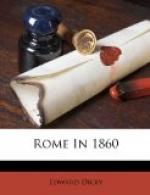to correct his children (and indeed on this occasion
correction was abundantly deserved by the insolent
demeanour of Luigi) could be considered to provoke
his son by a slight personal chastisement.”
The son, by the way, was over one and twenty, a fact
to which no allusion is made. As “a forlorn
hope,” in the words of the sentence, the counsel
for the defence asserted, that whatever the crime
of the prisoner might be, it was not parricide, from
the simple fact that Luigi was not Venanzio’s
son. The facts of the case appear to have been,
that Maria Rosa Battistoni being then unmarried, gave
birth in July 1835 to a son, who was the prisoner
at the bar; that shortly afterwards the vicar of Cannara
gave information to the Episcopal court of Assisi,
that Maria Rosa had been seduced by Venanzio Bonci
and had had an illegitimate child by him; that, in
consequence, a formal requisition was addressed by
the above court to Venanzio, and that he thereupon
acknowledged the paternity of the child, and expressed
his readiness to marry the mother. The marriage
was therefore solemnized, and the child entered in
the church-books as the legitimized son of Venanzio
and Maria Bonci, in June, 1836. Against this
strong presumptive evidence of paternity, and the
natural inference to be drawn from the child having
been brought up and educated as Venanzio’s son,
there were only, we are told, to be set, alleged expressions
of doubt on the father’s part, when in a passion,
as to his being really the father, and also certain
confessions of the mother to different parties, that
Luigi was not the child of her husband. All these
confessions however, so it is asserted, were proved
to be subsequent in date to the son’s arrest,
and therefore, probably, made with a view to save
his life. The plea is in consequence rejected.
No defence was attempted to the second count.
Both charges are therefore declared fully proved;
and as the punishment for parricide is public execution,
and the penalty for having in one’s possession
(a lighter offence by the way, than using) any weapon
without special license, consists of imprisonment
from two to twelve months, and of a fine from five
to sixty scudi, therefore the court “condemns
Luigi Bonci for the first count, to be publicly executed
in Cannara, and to make compensation to the heirs
of the murdered man, according to the valuation of
the civil tribunals, and to pay the cost of the trial;
and on the second count, the court” (with a
pedantic mockery of mercy) “considers the first
three months of the incarceration the prisoner has
already undergone to be sufficient punishment, coupled
with a fine of five scudi and the loss of the weapon.”
This summary will, I fear, give the reader too favourable
an opinion of the original sentence. In order
to make the story at all intelligible, I have had
to pick out my facts, from a perfect labyrinth of sentences
and parentheses. All I, or any one else can
state is, that these seem to be the facts, which seem
to have been proved by the witnesses. What the
character of the evidence was, or what was the relative
credibility of the witnesses, whose very names I know
not, or how far their assertions were borne out or
contradicted by circumstantial proof, are all matters
on which (though the whole character of the crime depends
on them) I can form no opinion whatever.




